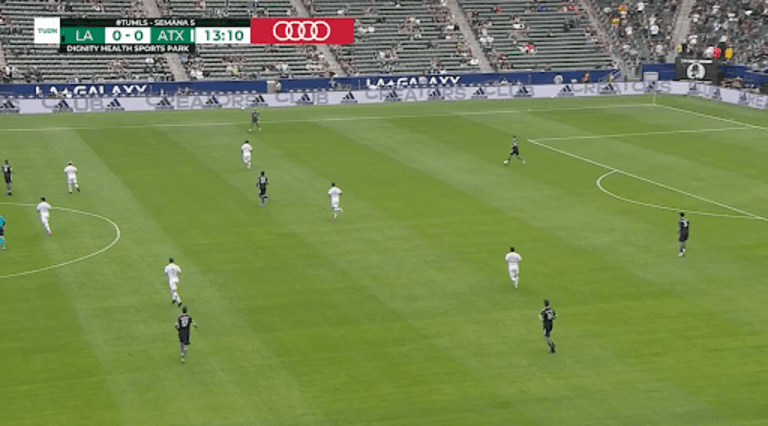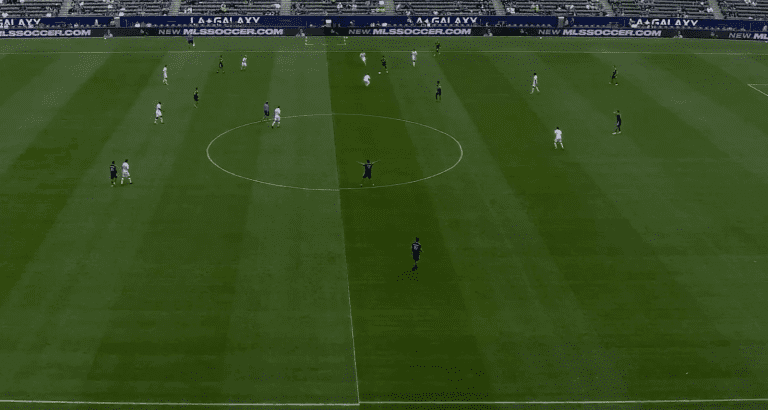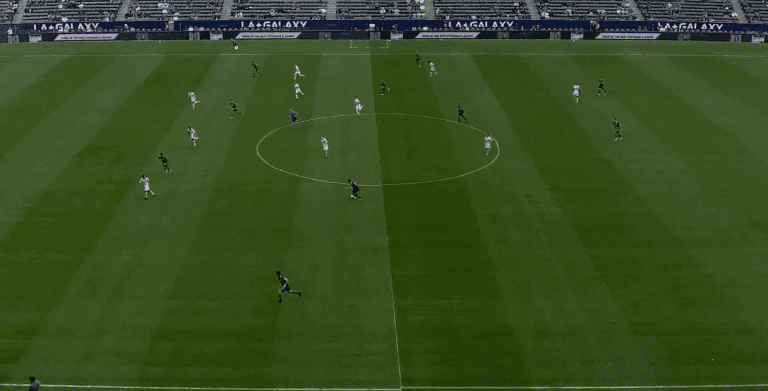Way back on April 17, Austin FC started their expansion season with lovely pieces of patient buildup play. Josh Wolff’s team came out and played through LAFC’s pressure in their first-ever game – and it was fantastic to watch. Though they didn’t create many chances, Austin made the field big and showed some impressive bravery in possession.
The issue in that game, besides their chance creation struggles, was Austin’s lack of defensive solidity. They allowed LAFC to take 24 shots, score two goals, and generate 2.7 expected goals. Unfortunately for Austin, that game wasn’t just a one-off. Per Second Spectrum, Austin FC have given up the most shots (156), the second-most shots per 90 minutes (17.7), the most xG (14.7) and the second-most xG per 90 minutes (1.7) in MLS this year. The season is young, but through their first eight games, Austin’s defensive issues have damaged their ability to get results.
Before I go any further, it’s important to note that Austin’s results have been okay this year. They’ve collected eight points from their first eight games, which is something that head coach Josh Wolff is “fairly pleased with,” according to his comments after Austin’s 1-1 draw with Sporting Kansas City last Saturday. It’s not easy to start MLS life with a lengthy road stretch while awaiting the opening of your soccer-specific stadium.
But ahead of Q2 Stadium debuting at full capacity this Saturday against the San Jose Earthquakes (9 pm ET | UniMas, TUDN, Twitter), what does Austin FC need to improve defensively? How can they boost their per-game numbers and climb the Western Conference table? Let’s dive in.
While they switched things up and defended in a 4-4-2 over the weekend against SKC, Austin have primarily used a 4-3-3 defensive shape this year. The 4-3-3 is a common high-pressing shape, but isn’t used as a mid-block shape by many coaches because of the lack of natural width across midfield. US men’s national team head coach Gregg Berhalter recently swapped his 4-3-3 for an “adaptive” defensive shape that looked an awful lot like a 4-4-2 for the majority of their 3-2 win over Mexico in the Concacaf Nations League final.
Too many times this season, Austin’s wingers in their 4-3-3 have been caught in no-man’s land. They’ve been caught between high pressing and mid-block defending, which has often left big gaps on the outside of Austin’s midfield (if you want to think about it horizontally) and in between their fullbacks and wingers (if you want to think about it vertically).

And just 30 seconds after the above image, here’s a look at what can happen when Austin doesn't win the ball in their press. Sebastian Lletget is hanging out in the pocket of space outside Tomas Pochettino and between Jared Stroud and Hector Jimenez.

The Galaxy find Lletget and they’re off to the races.

The above images illustrate a mistake in Austin’s aggressive press. But similar mistakes happen when Austin defend deeper in their own half, too.
This clip, taken from the same 2-0 loss to the Galaxy, shows how LA moved the ball into those outer pockets. Austin are caught between pressing and defending in any sort of compact defensive structure, their midfield pressure is late and they allow a game-sealing goal from Chicharito.
In their 2-1 loss to SKC one week earlier, Peter Vermes’ team picked apart Austin’s lower defensive block with dangerous passes from those pockets on the outside of midfield.
I spliced a handful of SKC’s attacks into this little video. All four of the moments lead to shots, including one high-xG header from Gianluca Busio (worth .213 xG, per Second Spectrum).
Wolff’s switch to the 4-4-2 for Austin’s second meeting with Sporting was very likely designed to make it harder for SKC to create dangerous chances from those outer pockets. With a bank of four across midfield, you have more natural width than you do with just three central midfielders (or three central midfielders and two disconnected wingers).
In theory, it was a clever idea. In actuality, SKC still targeted the space between Austin’s wide midfielders and their fullbacks by creating 1.8 xG in open play against Austin’s organized defensive shape. Regardless of their defensive shape, Austin FC have allowed the third-most shots per 90 minutes while organized (10.7) and the fourth-most xG per 90 (0.91). They struggle to compress space in their own half and defend in a compact structure.
Finding a balance between instructing their wide attackers to press and instructing them to stay connected to their central midfield teammates will be key for Austin as they continue their expansion season.
The other major defensive area where Austin FC currently struggle is transition moments. Austin allow the most shots per 90 minutes in defensive transition (7) in MLS, as well as the second-most xG per 90 (0.76). Austin will counter-press – they’re 11th in MLS in terms of team presses in defensive transition. However, they only win the ball back within five seconds on 41.67% of those counter-pressing moments, which is 23rd in the league.
Against the Galaxy, Austin looked extremely sluggish in defensive transition. That sluggishness left their own backline exposed and led to easy chances for their opponents:
And during a 1-0 loss to Nashville SC on May 23, an unfortunate turnover in possession and lax counter-pressure allowed Nashville to score the game’s only goal:
Wolff’s desire to mold Austin FC into a ball-dominant, aggressive team can’t actually come to fruition while his team is losing out on so many moments to win the ball with counter-pressure. High-volume possession play is predicated on quick ball recovery, which is something that Austin have lacked through their first eight games.
Now, it hasn’t been all bad for Austin defensively. Goalkeeper Brad Stuver has enjoyed an exceptional start to 2021, only allowing nine goals on 14.68 xG. He’s saving goals at an incredible rate and leads MLS in goals allowed below expectation by more than a goal. Though he’s been excellent, Austin FC won’t want to rely so heavily on Stuver as they enter a stretch of seven of their next nine games at Q2 Stadium. They would be better suited by establishing a more compact defensive shape and applying more aggressive pressure in defensive transition moments.
If those two things happen, Austin can certainly start climbing the Western Conference table and take advantage of their home-heavy schedule after this early-season road marathon.












